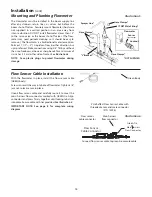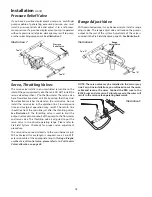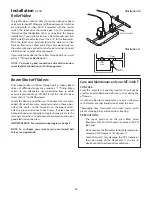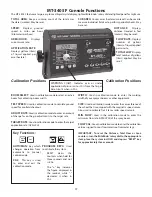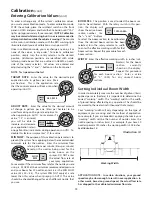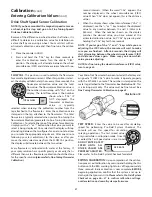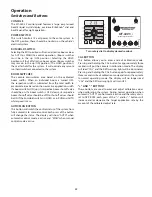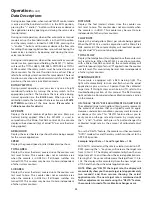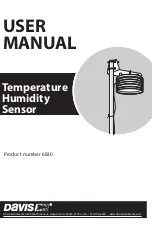
28
If there is no response from any of the following tests, refer to
the main wiring diagram on the pre vi ous page to locate the
next connector in line to ward the con sole and repeat the test
at that con nec tor. If there is a response at that connector, the
problem may be in the cable between the two connectors (or
the con nec tors themselves).
SPEED INPUT
Turn rotary switch to speed po si tion and dis con nect the
speed sensor (yel low tie) from the main harness. Check
for 12 volts between pins B (white) and C (black) of the
main harness speed cable (yellow tie). Using a clip lead
or other jumper wire (such as a paper clip bent in a “U”),
several times rap id ly short to geth er pins A (red) and C
(black) of the 3-pin connector
(See Illustration 26).
The
console should respond with some speed read ing.
FLOW INPUT
Turn rotary switch to flow rate (not spray rate) and
disconnect the flow sen sor (green tie) from the main
harness. Check for 12 volts be tween pins B (white) and C
(black) of the main harness flow cable (green tie). Using
a clip lead or other jumper wire (pa per clip bent in a “U”),
several times rapidly short together pins A (red) and C
(black) of the 3-pin connector
(See Il lus tra tion 20).
The
con sole should re spond with some flow rate reading.
FLOWMETER
Shaking the Flowmeter end to end should pro duce a “rattling”
sound (shaft end play). Blowing in the meter from either end
should spin the turbine freely. If the turbine spins freely but
the meter will not register flow with a known working sensor,
the turbine may be defective. See Flow me ter Assembly and
clean ing on page 36 for details.
ELECTRIC BOOM VALVES
If 12 volts and signal are present, but valves will not activate,
consult valve manufacturer’s troubleshooting instructions.
C
B
A
Three-Pin Connector
Illustration 20
Troubleshooting
Console Inputs
SERVO VALVE CONTROL SIGNAL
Flip the power switch to ON, put the console in MANUAL
mode, place the Run/Hold switch in the RUN position and
turn all boom switches to ON. Using a voltmeter, check from
a good frame ground to each of the servo wires on the main
harness connector (Harness must be disconnected from
servo valve.). You should get zero volts on each wire. Holding
the “+” button should cause the RED wire on the three-pin
connector (VIOLET wire on ten-pin connector) to pulse
toward twelve volts and the BLACK wire on the three-pin
connector (GRAY wire on ten-pin connector) should remain
at zero. Holding the “-” button should show the opposite
results.
SERVO VALVE
The best way to test the servo valve is with a known working
console. Flip the power switch to ON, put the console in
MANUAL mode, place the Run/Hold switch in the RUN
position and turn all the boom switches to ON. With the
servo valve connected to the servo valve lead on the main
harness, holding the “+” button should close the servo valve
and holding the “-” button should open the servo valve
(provided the console has passed the Servo Valve Control
Signal test). The servo valve should operate smoothly from
fully open to fully closed, in both directions.
You may also use a 9-volt transistor battery. Connecting the
battery to each terminal on the servo valve should cause the
servo valve to run in one direction. Reversing the battery
connections should cause the servo valve to run the other
direction. The servo valve should operate smoothly from fully
open to fully closed, in both directions.
DO NOT
connect 12
volts directly to the servo valve. Damage may result.
PLUMBING
Proper plumbing is a very important factor in obtaining
optimal performance from your MT-3405 system.
The chart
on page 29 will help you determine what area of the plumbing
may be causing your problem.
At this point, it is assumed that
your plumbing basically matches that of the system diagram
on page 7 and that the servo valve and flowmeter are known
to be installed correctly and functioning properly. In addition,
make certain that you have selected and installed the correct
spray tips for the application, speed and spray rate that you
intend to maintain. Don’t forget the obvious such as leaky
fittings and hoses, pinched hoses and plugged or worn
nozzles.
If you need more detail than the chart provides,
please refer to Plumbing Guidelines on page 30.
Содержание MT-3405 LR F
Страница 1: ...MT 3405 F LR AUTOMATIC RATE CONTROLLER REFERENCE MANUAL TM ...
Страница 33: ...33 Appendices ...

